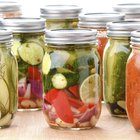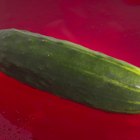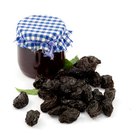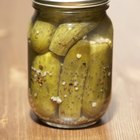etiennevoss/iStock/GettyImages
Although you can freeze salsa prepared with canned tomatoes simply by packing the salsa in freezer-safe boxes or bags, the quality of frozen salsa begins to deteriorate after just a month or two. For longer storage, preserve salsa by canning it in a water bath or pressure canner. Water bath canners are the simplest, most affordable solution. If you opt for a pressure canner, be sure it's a canner, not a pressure cooker. For safety's sake, follow all recipe directions exactly.
Canning Basics
To preserve salsa made with canned tomatoes, you'll need either a water bath canner or a pressure canner. Pour hot salsa into clean, hot pint or quart jars, leaving 1/2 inch of headspace at the tops of the jars. Run a plastic spoon around the insides of the jars to remove air bubbles. Wipe the rims of the jars with a damp paper towel to remove any food debris. Place the lids on the jars, followed by the rings. Place the jars in a water bath canner filled with hot water. The water should cover the jars by at least 1 inch. Bring the water to a full rolling boil and put the lid on the canner. Process according to the recipe directions -- typically 15 to 20 minutes. Increase the processing time if you live at high altitude at a rate of five minutes for each 5,000 feet above sea level. To process the salsa in a pressure canner, place the prepared jars in the canner. Seal the lid on the pressure canner and set the weight at 10 pounds. Process pint jars for 20 minutes and quarts for 25 minutes, or according to the recipe instructions.
Keep It Safe
Most varieties of fresh and canned tomatoes are fairly acidic, so they don't need to be cooked in a pressure cooker. However, if you add other ingredients, such as onions and peppers, you now have an alkaline product. When canned improperly, alkaline vegetables may allow bacteria to grow. This bacteria can cause serious foodborne illness or even death, if consumed. To eliminate this worry, all alkaline foods -- including salsa -- should be processed in a pressure canner or canned with an acidic ingredient, such as vinegar. Stick with recipes from a reliable source, such as the U.S. Department of Agriculture, and follow them exactly. Choose salsa recipes that call for vinegar or lemon juice. Don't worry about an off-flavor from the vinegar. When canned, the vinegar merely adds a bit of bite which improves the salsa's taste.
Set It Aside
Once the timer goes off, use a jar lifter and an oven mitt to remove the jars from the pressure canner or water bath canner. Place the jars on a clean kitchen towel on the countertop so air circulates between the jars. Allow the jars to cool for at least eight hours or overnight. Check the jars to make sure they've sealed by pressing lightly on the lids. The lids should feel flat and firm. If they pop or bounce back, the jars haven't sealed. Refrigerate and use unsealed jars immediately or reprocess them. Wipe down sealed jars and remove the rings. Place the jars of salsa in a cool, dry location and use them within one year.
A Bit of Heat
When making salsa with canned tomatoes, heat the salsa over medium heat until it simmers. Cooking the salsa softens other vegetables, such as onions and peppers, and also helps stabilize the mixture so it's less likely to separate or become watery after you've canned it. Cut the vegetables uniformly or prepare them in a food processor. Add a bit of tomato paste if the salsa seems too thin. Season the salsa sparingly. Chili peppers become hotter as they sit in canned salsa. Other spices, including oregano and thyme, can become bitter. Cooked cilantro has almost no taste at all. It's best to use small amounts of herbs and spices and add more seasoning to open jars of salsa if necessary.
Related Articles

How to Process & Seal Hot Sauce Bottles

How to Preserve Bell Peppers for Use ...

How to Can Pickled Corn in Jars

How to Blanch, Peel, & Freeze Whole ...

How Long to Can Green Beans in a Hot ...

How to Preserve Nectarines
Can You Freeze Capers?

How to Preserve Pimentos

How Long Can Fresh Salsa Be Left Out?

How to Can Green Tomatoes & Peppers ...

How to Convert Sour Pickles to Sweet ...

How to Make Delicious, Homemade ...

How to Can Jelly Using a Pressure Canner

How to Can Homemade Vegetable Beef Soup
Do You Need to Pasteurize When Pickling ...

What Are the Seeds in Pickle Jars?

How to Preserve Sauerkraut

How to Can Salmon Fish
How Long Can Canned Pickles Stay Good?
How Long Can Food Stored in Canning ...
References
- Complete Guide to Home Canning and Preserving: U.S. Department of Agriculture
- The Big Book of Preserving the Harvest; Carol W. Costenbader
Writer Bio
Julie Christensen is a food writer, caterer, and mom-chef. She's the creator of MarmaladeMom.org, dedicated to family fun and delicious food, and released a book titled "More Than Pot Roast: Fast, Fresh Slow Cooker Recipes."